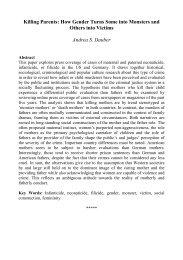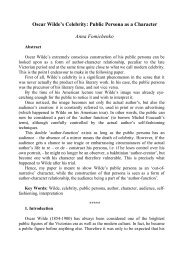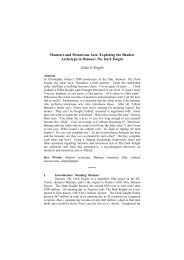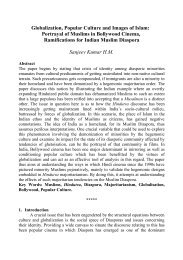The 'green-eyed monster': jealousy and erotic monomania in He ...
The 'green-eyed monster': jealousy and erotic monomania in He ...
The 'green-eyed monster': jealousy and erotic monomania in He ...
You also want an ePaper? Increase the reach of your titles
YUMPU automatically turns print PDFs into web optimized ePapers that Google loves.
1 Shakespeare, Othello, III.iii. l. 165-7.<br />
2 Ian Watt, <strong>The</strong> Rise of the Novel: Studies <strong>in</strong> Defoe, Richardson <strong>and</strong> Field<strong>in</strong>g (Harmondsworth:<br />
Pengu<strong>in</strong>, 1970), 154.<br />
3 D. A. Miller has argued that novels end<strong>in</strong>g <strong>in</strong> happy marriages, like Jane Austen’s, ‘<strong>in</strong>hibit narrative<br />
productivity.’ Emma <strong>and</strong> Mr Knightley’s marriage, for <strong>in</strong>stance, ‘must end the novel…otherwise, it<br />
would not be a “perfect” union.’<br />
Narrative <strong>and</strong> Its Discontents (Pr<strong>in</strong>ceton, New Jersey: Pr<strong>in</strong>ceton University Press, 1981), 4.<br />
4 Kelly Hager, Dickens <strong>and</strong> the Rise of Divorce: <strong>The</strong> Failed-Marriage Plot <strong>and</strong> the Novel Tradition<br />
(Farnham, Surrey: Ashgate, 2010).<br />
5 Wilkie Coll<strong>in</strong>s, <strong>The</strong> Woman <strong>in</strong> White (Ware, <strong>He</strong>rtfordshire: Wordsworth, 1993), 174.<br />
6 For example, Emily Blair argues for a different area of cont<strong>in</strong>uity from Victorian novelists to Woolf,<br />
<strong>and</strong> writes that ‘Woolf’s depiction of fem<strong>in</strong><strong>in</strong>ity resonates with the depictions of Gaskell <strong>and</strong> Oliphant<br />
as she simultaneously re<strong>in</strong>vents the novel <strong>and</strong> revises the marriage plot.’ Virg<strong>in</strong>ia Woolf <strong>and</strong> the<br />
N<strong>in</strong>eteenth-century Domestic Novel (Albany: State of New York Press, 1997), 9.<br />
7 John Galsworthy, In Chancery, <strong>The</strong> Forsyte Saga (Oxford: Oxford University Press, 2008), 514.<br />
8 Just fifteen years before the publication of this section of the saga, Hardy’s Tess of the D’Urbervilles<br />
sc<strong>and</strong>alised readers with its portrayal of the raped woman as a morally pure victim. Galsworthy’s Irene<br />
is similarly <strong>in</strong>nocent of all blame for the violence she experiences.<br />
9 Hager, Dickens <strong>and</strong> the Rise of Divorce, 8.

















